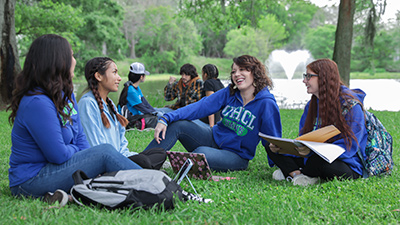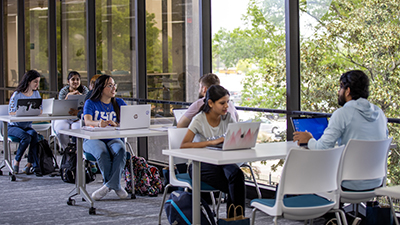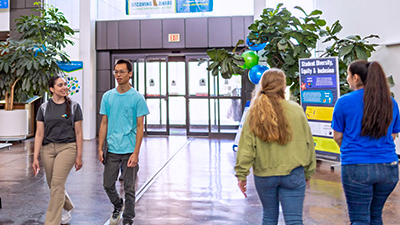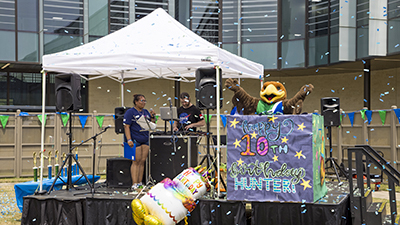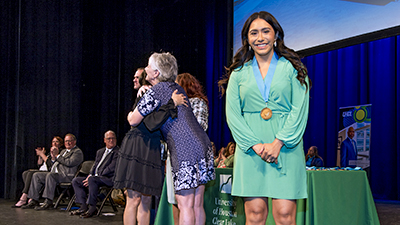
Science Engineering Colloquium
Spring 2018 - Schedule
Location: Delta 241
Time: 12:00 p.m. ‐ 1:00 p.m. (Refreshments: 11:45 a.m. ‐ 12:00 p.m.)
Hosted by the College of Science & Computer Engineering
| Date | Presentation | |||
|---|---|---|---|---|
| 4/23/2018 |
Toward Edge Computing for IoT SecurityDr. Kewei Sha Dr. Kewei Sha is an Assistant Professor of Computer Science and Associate Director of Cyber Security Institute at University of Houston - Clear Lake (UHCL). Before he moved to UHCL, he was the Department Chair and Associate Professor in the Department of Software Engineering at Oklahoma City University. His research interests include Internet of Things, CyberPhysical Systems, Edge Computing, Network Security and Privacy, and Data Management and Analytics. His research has been supported by NSF and UHCL. Dr. Sha has served as guest Editors at several prestigious technical journals, and organizing committee members of many conferences, including the TPC Chair of IEEE ICCCN 2015. He is also a reviewer for numerous top journals like many IEEE transactions. He is a Senior member of ACM and a Senior member of IEEE. Dr. Sha is a recipient of IEEE Outstanding Leadership Award and 2018 Albert Nelson Marquis Lifetime Achievement Award. Host: Dr. Ahmed Abukmail |
|||
| 4/9/2018 |
RFID and It’s Many Industrial AdaptabilityDr. Zafar Taqvi The Radio Frequency Identification (RFID) technology with its simplicity has found
widespread application in wide range of industries. It provides an ideal technology
for tracking assets and identifying them by using a simple low cost hardware. It also
provides an automatic data collection. This presentation will present the technology
of RFID, its various applications and benefits. Host: Dr. Tom Harman |
|||
| 3/26/2018 |
Learning to Identify Symptoms of Cancer in Young Children Using Natural PhotographsDr. Greg Hamerly The most common solid-tumor pediatric cancer is retinoblastoma, where tumors grow
on the retina of the eye. Affecting roughly 1 in 10000 births, in resource-limited
settings, about 50% of children with this condition Host: Dr. Hisham Al-Mubaid |
|||
| 2/26/2018 |
Privacy in Data Publishing & Social NetworksDr. Lila Ghemri This talk will present projects that were part of two DHS funded research Centers:
the DHS Center of Excellence for Dynamic Data Analysis (DyDan) and the DHS Command,
Control and Interoperability Center for Advanced Data Analysis(CCICADA) with Rutgers
University as lead. Host: Dr. Hisham Al-Mubaid |
|||
| 2/12/2018 |
Space Exploration Technology Drives InnovationMr. Chris Culbert Mr. Culbert has spent more than 30 years developing technologies and systems for human spaceflight at the Johnson Space Center. He is currently the Chief Technologist for Johnson Space Center, responsible for coordinating center strategies for technology development and supporting agency wide activities for the NASA Office of the Chief Technologist. During his career he has managed the development of advanced technologies in robotics, automation, avionics and software for Space Shuttle, Space Station, and advanced human missions. Host: Dr. Hisham Al-Mubaid |
|||
| 1/29/2018 |
Dr. Luay Nakhleh A phylogeny represents the evolutionary history of a set of taxa from their most recent common ancestor. It provides a powerful framework for organizing, interpreting, and analyzing biological data "in the light of evolution." The post-genomic era has provided the data to make phylogeny reconstruction more accurate. However, this accuracy does not come without modeling and computational challenges. In this seminar, I will describe our efforts in phylogeny reconstruction in two areas: cancer evolution and species evolution. In the case of cancer evolution, I will present our recent work on phylogenetic inference from single -cell genomic data. The challenge here is to carefully account for the noise in the data. In the case of inferring species evolutionary histories, the major challenge is that the evolutionary history of species (and populations and sub-populations) could be incongruent with the evolutionary histories of individual loci within the genomes of these species. I will describe our work on modeling two processes that underlie this incongruence, namely incomplete lineage sorting and gene flow. Host: Dr. Hisham Al-Mubaid |
|||
Location: Bayou 2512
Time: 12:00 Noon – 1:00 PM (Refreshments: 11:45 a.m. – 12:00 noon)
Hosted by the College of Science & Computer Engineering
| Date | Presentation | ||
|---|---|---|---|
|
4/19/2018 |
Monitoring and Mapping the Soil and Water Quality Dynamics of Urban Watersheds in TexasDr. Maruthi Sridhar B. Bhaskar The rapid land use and land cover changes due to intense urbanization has a significant effect on ecology, environment, and human health in most of the urban watersheds. The recent increase in frequency and intensity of the urban flooding events and repeated inundation of the neighborhoods along the Greens, Buffalo, Halls, and Hunting Bayous makes it important to monitor the water and soil chemical characteristics in these watersheds. The objectives of this study are to 1) Monitor the historical water quality data of the selected bayous, and 2) to collect and analyze the nutrient, heavy metal and bacterial concentrations in the water and soil samples along the bayou. Historical water quality data from the past three decades of the bayous were downloaded from the USGS database, processed and analyzed for time series analysis. Water and soil samples, from different sampling locations along the Greens, Buffalo, Halls, and Hunting Bayous were collected and processed for chemical and bacterial analysis. The water samples were analyzed for C and N concentrations using TCN (Total Carbon Nitrogen) analyzer and for nutrient and metal concentrations using ICPMS (Inductive Coupled Plasma Mass Spectrometry) analyzer. Soil samples were also analyzed using the handheld XRF (X-ray Fluorescent) analyzer. Our water analysis revealed that the C, N, P, K, Ca, Mg and Zn concentrations were significantly higher in upstream compared to downstream of Greens and Halls Bayou. The soil analysis indicates that the Fe, Mn, K, S and Zn were significantly higher in upstream compared to downstream of the Bayous. All the metal concentrations in the water were found to be below the critical limit while the N and P concentrations exceeds the critical limit. The analysis of the metal and nutrient concentrations in water and soil will enable us to identify the non-point sources of contamination, which can be better managed to preserve the health of this urban watershed ecosystem.is often difficult, and I further show how this theoretical work can be used to infer transverse statistics using experimentally accessible longitudinal observables. Finally, I discuss how an external tension can significantly alter the free energy landscape of confined biomolecules, with implications for our understanding of histone unbinding from DNA. Host: Dr. Yi Su |
||
|
4/12/2018 |
Quantifying the Statistics of Confined Biomolecules in Vitro & in VivoDr. Greg Morrison University of Houston, Department of Physics Single molecule biophysics has produced a number of theoretical and experimental advances in recent decades, with implications for understanding the physical principles that are essential for life. In particular, the confinement of stiff macromolecules to nanochannels and nanoslits has recently provided a new platform for the study and manipulation of single molecules such as DNA and F-Actin. In this talk, I will give a brief introduction to single molecule biophysics and some of the modeling choices that must be made in understanding these systems theoretically, ranging from all atom simulations to coarse grained polymer physics. Using Monte Carlo simulations and a simple polymer model, I determine the bending correlation functions for stiff chains confined to a channel and slit in the transverse and longitudinal directions. These predictions are shown to satisfy known scaling laws for confined wormlike chains and more accurately capture the quantitative details of the transverse bending correlations than the existing weakly bending rod predictions. Direct measurement of the transverse statistics is often difficult, and I further show how this theoretical work can be used to infer transverse statistics using experimentally accessible longitudinal observables. Finally, I discuss how an external tension can significantly alter the free energy landscape of confined biomolecules, with implications for our understanding of histone unbinding from DNA. Host: Dr. Samina Masood |
||
|
4/5/2018 |
Understanding Tick-Borne Hemorrhagic Fever VirusesDr’s. Dennis Bente, Tais Salto and Sergio Rodriguez University of Texas Medical Branch, Galveston The research focus in our lab is on tick-borne hemorrhagic fever viruses such as CrimeanCongo hemorrhagic fever. What makes our research most unique is that my team and I are studying this family of diseases under maximum biocontainment conditions in the BSL4 laboratories of UTMB’s Galveston National Laboratory. Within the unique research facilities of the GNL, my team is breaking new ground in the worldwide fight against these diseases. We strive to innovate – not just in the lab, but in communicating the science, practices and findings. Working with some of the world’s most dangerous viruses is multifaceted and intricate, but we want to break down the complexities of our discipline and ignite an understanding that breeds excitement in all audiences. When we can help people truly understand these diseases – on their own terms – our field is stronger for it. Host: Dr. Lory Santiago |
||
|
3/29/2018 |
The Challenges of a Space Janitor: From Counting Bacteria to Building the James Webb Space TelescopeYingrui Zao Huang, Contamination Engineer The James Webb Space Telescope (JWST) is NASA’s next generation space telescope, slated
to launch in 2019. It is the largest space telescope ever built. This immense goal
comes with many unique challenges for contamination control engineers (space janitors).
This presentation will explore 3 main areas: integration, material science, and vacuum
dynamics. Host: Dr. Samina Masood |
||
|
3/22/2018 |
OSHA, Myth and RealityMark R. Briggs, CSP In this presentation we will be taking a look at who OSHA is and what they are all about as well as debunking some of the more popular myths surrounding the agency. Join Area Director Mark Briggs as he takes us behind the scenes into a critical agency of the federal government that has an impossible task but whose mission is to save your life! Host: Dr. Magdy Akladios |
||
|
3/8/2018 |
HERA: Human Exploration Research Analog Research Mission: Isolated, Confined and ControlledDr. Patrice O. Yarbough The Human Exploration Research Analog (HERA) is a high-fidelity analog research location for scientists to use in addressing risks associated with human performance during spaceflight. HERA is a ground-based analog used by the NASA Human Research Program to study how isolation and confined habitation (associated with long-duration missions) impact individuals and the team. Studies in a research environment, that produce affects on the human body similar to those experienced in spaceflight, can be completed faster than in flight. HERA Campaign 4 is a 45-day confinement study, with two weeks of pre-mission baseline studies and one week of post-mission study. Total commitment time is 68 days to simulate flight operations and confinement. The presentation will include the research mission design with HERA conditions and capabilities. Host: Dr. Lory Santiago-Vasquez |
||
|
3/1/2018 |
The 3-km High Subjovian Megadome on Ganymede: Simulation of Stability via Pratt IsostasyDr. Johnathan Kay Overview of Jupiter’s moon Ganymede will be presented. The focus of the research is determining a way to support a large dome on an icy satellite in which tradition methods of support (crustal roots) are not available. Host: Dr. Gerald Pollack |
||
|
2/22/2018 |
Root Responses to Iron Deficiency: Metabolic Adaptations and the Role of FlavinsDr. Ana Flor Lopez Millan Iron is an essential micronutrient for all living organisms including plants, since it takes part in fundamental biological redox processes such as photosynthesis and respiration. Although Fe is the fourth most abundant element in the earth’s crust, the bioavailability for plants is low, due to its poor solubility in the rhizosphere at neutral or basic pH. Therefore, Fe deficiency is a yield-limiting factor with major implications for field crop production in many agricultural areas of the world. When Fe is scarce, plants develop morphological and biochemical changes in roots leading to an increase in their Fe uptake capacity. Biochemical changes induced by Fe-deficiency include an activation of the components
involved in the root acquisition of this element which include a plasma-membrane Fe(III)-reductase,
an Fe(II) transporter and an enhanced proton extrusion capacity mediated by a plasma-membrane
ATPase. Research towards the elucidation of the metabolic adaptations occurring in
roots in order to sustain the elevated energy requirements of this uptake system will
be discussed. In addition, plants grown in Fe-deficient conditions excrete a plethora
of organic compounds, including carboxylates, phenolics and flavonoids, that can affect
Fe availability and whose roles are still a matter of debate. The root accumulation
and excretion patterns of riboflavin and its derivatives in different Fe deficiency
conditions and their possible roles in roots and in the rhizosphere will also be presented
in this seminar. |
||
|
2/15/2018 |
Macroscopic Quantum Tunneling in Long Josephson JunctionsDr. Eric Van Mayes An investigation of the macroscopic quantum tunneling of bound fractional fluxon pairs is discussed. These fluxons arise due to the time reversal symmetry breaking in a long Josephson junction (LJJ) with two-band superconductors. The spatial dependence of the critical current density can generate magnetic flux in the insulator layer, creating fractional fluxons with large and small fractions of flux quantum. The interaction between the two is repulsive at short distances, but attractive at long distances, causing the formation of what is essentially a fractional fluxon molecule. This molecule can tunnel through a barrier potential at low temperatures when placed in a metastable state formed by a microresistor in the insulator layer and a bias current to the LJJ. These fractional fluxon pairs may be observable if their separation is large enough and the tunneling rate long enough. Host: Dr. Samina Masood |
||
|
2/08/2018 |
Source Identification of Carbon in Size-Fractionated PM and Time-Resolved Bulk PM10 Using Radiocarbon and Molecular Source MarkersDr. Hyun-Min Hwang In many urban areas, atmospheric particulate matter (e.g., PM10, PM2.5) has been linked to various health issues such as asthma, lung cancer, and premature death. To improve understanding of the sources of atmospheric carbonaceous particulate matter, size-resolved PM (0.056 to1.8 µm) and time-resolved bulk PM10 collected in Sacramento, California were analyzed for radiocarbon and source markers such as levoglucosan, alkanes, and elemental carbon (EC). The contributions of modern (non-fossil) carbon sources were much greater than that from fossil carbon sources in all samples. Radiocarbon and source marker measurements confirm that the greater contribution of non-fossil carbon sources in November samples was due to residential wood combustion. The results provide additional evidence that wood combustion was likely a significant source of EC in November samples, and demonstrate that using EC as a diesel emission tracer may not be appropriate in areas where wood combustion could be a confounding source of EC. Levoglucosan to organic carbon (Levo/OC) ratios in all PM10 samples showed a strong negative correlation with fossil carbon content. Fossil originated carbonaceous PM10 could account for about 40% of the total carbonaceous PM10 in the study area when the contribution from wood combustion is zero. The results of the present study demonstrate the value of combining radiocarbon and conventional source markers for more robust and detailed source attributions for ambient PM. Host: Dr. Arcadius Krivoshein |
||
|
2/01/2018 |
Impact of Hydraulic Fracturing on EnvironmentDr. Guoqing Liu Over the past decade, hydraulic fracturing in the horizontal well is the critical
technology in the shale gas/oil revolution. It has significantly changed the petroleum
industry in the United States and the rest of the world. However its potential impacts
on the environment has been a public concern for a long time. This presentation is
to illustrate the safety and the potential environmental damages of the hydraulic
fracturing technology. Host: Dr. Dongmin Sun |
||
